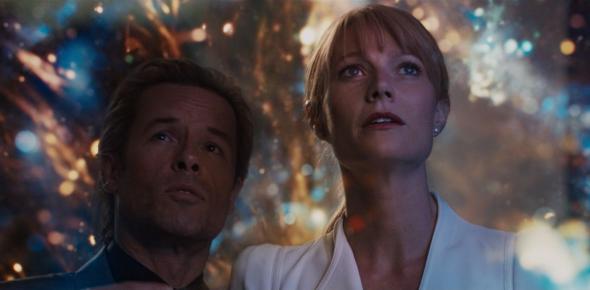The biggest mystery in Guardians of the Galaxy Vol. 2, the only major secret that was not revealed in advance by the film’s marketing, is a simple one: Who is the villain? I won’t spoil the answer, but helpfully, when the Big Bad finally does, this baddie has done what so many baddies have done lately. This supervillain has prepared a thorough multimedia presentation.
It’s nothing new for villains to explain their evil plans, of course. For as long as there have been madmen bent on world domination, those bad guys have been extraordinarily forthcoming about their schemes—especially when addressing the only people who could stop them. A previous Marvel Studios movie, Age of Ultron, even pulls off a meta-joke about this: When Ultron is prodded by Iron Man to reveal his designs on world domination, the villain responds, “I’m glad you asked that, because I wanted to take this time to explain my evil plan.” (Rather than holding forth, he surprises the heroes by attacking immediately.)
But lately many supervillains have been taking things to a whole new level. Like wannabe entrepreneurs, they’ve begun preparing their own pitch decks, complete with slides and videos and futuristic holograms. If Game of Thrones has “sexposition” (in which the show uses nudity to hold the viewer’s attention while delivering dry plot exposition), superhero movies have what I’d call “decksposition.” It’s no less shameless, and a lot more dull, because decks are a lot less sexy than sex.
To be fair, the method of conveying exposition in a film through literal lectures and slideshows isn’t new, either. It’s been around since at least Fritz Lang’s 1933 The Testament of Dr. Mabuse. And holograms have been used to deliver plot since Princess Leia first begged Obi-Wan Kenobi for help.
But it’s Marvel Studios that’s combined these threads to make the holographic info-dump a summer-movie staple. It started with the Iron Man movies, where, given Tony Stark’s entrepreneurial streak, it at least felt more natural to the territory. It’s plausible that a huckster like Stark might recap the night of his parents’ death via a hologram presentation at an Massachusetts Insitute of Technology alumni honors event, as he does in his co-starring role in Captain America: Civil War.

Screengrab from Netflix
The hologram technology Stark uses (which in the real world is still at least a few years off) is a regular feature of the Iron Man franchise. But by Iron Man 3, the series’ villains had started delivering their own evil TED Talks. In that 2013 movie, Guy Pearce’s Aldrich Killian explains the fictional technology he will use to try to take over the country, via a holographic livestream of his brain.
It was that same year that decksposition also made the jump to the films of the DC Extended Universe. In Man of Steel, Jor-El appears to give Superman a presentation on Kryptonian history, complete with the Kryptonian equivalent of Microsoft PowerPoint or Apple Keynote. (Jor-El does seem to have a taste for this kind of thing.)
And over in the Marvel universe, these multimedia infodumps have begun to appear in movies that don’t have anything to do with Tony Stark. A few years ago, 2014’s Captain America: The Winter Soldier, for example, offered a retro spin on decksposition. In that film, villain Arnim Zola (Toby Jones) manages to stall Captain America and Black Widow by using the brilliant tactic of revealing the entire secret history of Hydra from World War II until the present day.
In Guardians of the Galaxy, the villain is, indeed, pitching a big, splashy idea that this mastermind believes will save the universe, making the pitch deck an oddly natural fit. But the presentation is so bizarre—so familiar and yet so over-the-top—that (based on an informal poll of co-workers) it’s unclear whether it’s supposed to be self-parody.
The cinematic PowerPoint has always been a extraordinarily clunky way to unload a bunch of backstory. (It’s not even a particularly good way to teach a college course.) Not that I envy the screenwriter his task. So overstuffed is the modern blockbuster with action set pieces, gags, and conversations about feelings that the poor scribe has but a tiny sliver of runtime during which he must explain his film’s actual plot. Under these conditions, it’s no wonder that screenwriters turn to a juiced-up version of the same tool used by any modern businessperson who must efficiently convey a lot of complex information to any room full of people. But no matter how much the visual-effects team might try to dazzle the viewer with 3-D graphics and bleep-bloop telemetry noises, to viewers, they feel about as exciting as the quarterly all-staff meeting.
